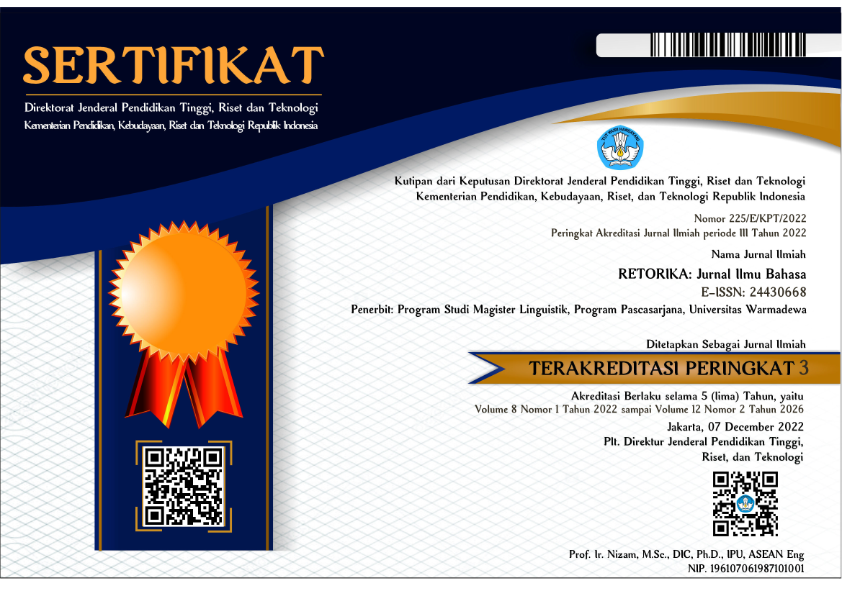Form and Meaning of Mosque Naming in Mataram City: Morphosemantic Study
Abstract
Research on the Form and Meaning of Mosque Naming in Mataram City: This Morphosemantic Study aims to describe the form of mosque names morphologically and examine their meaning semantically. This research is a type of research with a descriptive qualitative approach. The data in this research are the names of mosques in Mataram City, while the data sources in this research include mosque administrators, the public, articles and other media. The data collection method in this research uses the Listening method with advanced techniques, the Listening Involvement Cakap technique, the Free Listening Involvement Cakap technique, the Note taking technique and the Recording technique. Apart from that, the Listening method is strengthened by the Interview method with the Cakap Semuka advanced technique. Furthermore, it is also strengthened by the Documentation method. The data analysis methods used include the Intralingual Matching method, the Extra Lingual Matching method and the Distributional method. The method for presenting data analysis in this research uses informal methods. The results of this research include the morphological forms of mosque names which are classified into words and phrases. Based on their meaning, mosque names are divided into lexical meaning and contextual (socio-cultural) meaning.
References
Alwi, Hasan, et al. (2003). Standard Grammar of Indonesian, Third Edition. Jakarta: Balai Pustaka.
Chaer, Abdul. (2007). General Linguistics. Rineka Cipta
Damayanti, M. A. (2020). Lingual Form and Connotational Meaning in the Lyrics of Ebit G. Ade's Song in the Album There's Still Time. Mataram. Mataram University
Edi Subroto, D. (2007). Introduction to Structural Linguistic Research Methods. Surakarta: Sebelas Maret University Press.
Elfira, S. S. Naming Coffee Shops in Trawas District: A Study of the Meaning.
Faisol, Y. (2014). Morphology and Semantic Meaning of Mosques and Prayer Rooms in Padang City. Heritage, 2(1), 109-122.
Farid, E. K. F. (2020). Indonesian and Arabic Syntax: (Study of Contrastive Analysis of Phrases, Clauses and Sentences). Bahtsuna, 2(1), 139-156.
Fernandez, Y. D. (2022). Form and Meaning of Hamlet Names in Nelle District, Sikka Regency. Domain: Journal of Language Studies, 11(1), 232-242.
Hanifah, D. U. (2023). The Importance of Understanding Meaning, Types of Meaning and Changes. Ihtimam: Journal of Arabic Language Education, 6(1), 157-171.
Helda, M., Cristina, A., Fitri, F., & Angraini, R. (2023). The Meaning of Naming Villages in Pangkalan Kuras District, Pelalawan Regency. Poetry: Journal of Research and Service in Literature, Language and Education, 2(1), 95-99.
Wisdom. S. A. (2001). Island of a Thousand Mosques Study of Mosques as Centers for Religious Activities of the Sasak Lombok Community, West Nusa Tenggara (1980-2000). Yogyakarta. IAIN Sunan Kalijaga
Kridalaksana. (2007). Word formation in Indonesian. Jakarta: Gramedia Pustaka Utama
Mahsun. (2007). Language Research Methods. Jakarta: PT Raja Grafindo Persada.
Mahsun. (2019). Language Research Methods: Strategy Stages, Methods and Techniques. Depok: Rajawali Press.
Moeleong, Lexy J. (2007). Qualitative Research Methods. Bandung: Rosda Karya Youth
Moleong, Lexy J. (2017). Qualitative Research Methodology. Bandung: Rosdakarya Youth.
Nasution, I. P. (2017). Names of Ancient Mosques in the Archipelago and their Background Aspects: Toponymic and Archaeological Overview. In National Seminar on Toponomy (pp. 122-138).
Pradana, R. W. (2020). Forms and Symbolic Meanings of Decorations at the Sunan Giri Mosque. Space, 7(1).
Ramlan. (2001). Syntax. Yogyakarta: CV. Karyono
Salsabila, S. S., Komarudin, E., & Dayudin, D. (2021). Noun Phrases in Indonesian and Ismi Tarkib in Arabic (Contrastive Study). Hijai, 4(1), 96-107.
Sugiyono. (2018). Combination Research Methods. Bandung: Alphabeta.
Suharyani, T. (2017). Forms and Symbolic Meanings in the Architecture of the Kraton Saka Tunggal Mosque, Tamansari, Yogyakarta.
Tarmini, W., & Sulistyawati, R. (2019). Indonesian Syntax. Jakarta: Uhamka.
Tolinggi, S. O. R. (2019). Phrase Structure Based on Similarity of Distribution with Word Groups in Arabic. Shaut Al-Arabiyah Journal, 7(2), 121-131.
Verawati, V., Patriantoro, P., & Syahrani, A. Form and Meaning of Naming Rice Names in Tangaran District, Sambas Regency. Equatorial Journal of Education and Learning (JPPK), 11(10), 2007-2014.
Zidni, M. (2019). Form, Meaning and Function of Typical Phrases on Kiss Candy Wrappers. Mataram. Mataram University.
Copyright (c) 2023 RETORIKA: Jurnal Ilmu Bahasa

This work is licensed under a Creative Commons Attribution-ShareAlike 4.0 International License.
This journal provides immediate open access to its content on the principle that making research freely available to the public supports a greater global exchange of knowledge.
All articles published Open Access will be immediately and permanently free for everyone to read and download. We are continuously working with our author communities to select the best choice of license options, currently being defined for this journal as follows: Creative Commons-Non Ceomercial-Attribution-ShareAlike (CC BY-NC-SA)
 Abstract viewed = 139 times
Abstract viewed = 139 times
 PDF downloaded = 30 times
PDF downloaded = 30 times

2.png)














